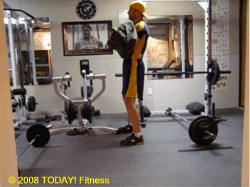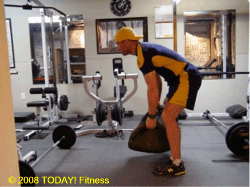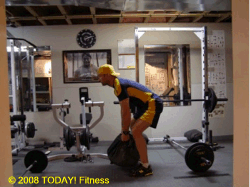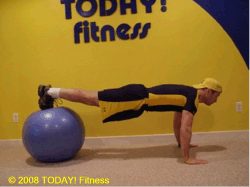|
Sandbag Training |
|
Time to take it Old School! I find it humorous that with
the endless variety of fitness gadgets and high tech equipment
that is in the market in this day and age, primitive training
regimes like sandbag training have renewed life. Personally
I love it. There's all kinds of terminology that you will
hear for this kind of training... underground training,
primitive training, gladiator training... it all comes down to
performing strength training exercises with non-standard objects
that you typically won't find in your local health club or spa.
At the top of the current list of primitive training techniques
you will find tractor tire flipping, sledgehammer training, log
training, stone training, sled dragging and pushing, and of
course sand bag training.

Zercher
Front Squat
For hundreds of years sandbags have been an integral training tool for
athletes, specifically wrestlers. They are an inexpensive
tool that is incredibly versatile and can offer the benefits
of unstable training with a challenging load. This is a
benefit that many of today’s unstable gadgets can not provide.
However, the benefits don’t stop there. Greater stabilizer,
trunk, and grip strength can be developed with sandbags as
well as sport-specific drills, and mobility work. They
are a great
conditioning tool.
Sandbags can be thought of
as the most “uncooperative” pieces of equipment. They are
different because they will change their form as you lift
them. Unlike many other training tools, it is almost
impossible to develop a specific groove for any lift. This
makes sandbags a constant challenge as every repetition will
be vastly different.
Sandbags work your body in ways you could not approach with
a barbell alone. You get into the muscle areas you normally
don’t work. You worked the heck out of the stabilizing
muscles. Increasing
the strength of the stabilizers can both decrease your risk of
injury and improve performance.

Bent-over Row
The non-cooperative nature of sandbags makes it crucial to
use every
muscle possible to lift them. More stable and
predictable implements can cause the body to find a particular
groove. Once this groove is established then one becomes more
efficient at performing the lift and the body actually
decreases the amount of muscles utilized.
With explosive sandbag lifts such as cleans,
throws, snatches, and shouldering, the trunk muscles
(including those of the low back and abdominal area) have to
work harder to stabilize the body against the awkward load
while moving very quickly. This is very unique to sandbag
training.
With sandbags we can also create amazing rotational drills
that place the body into ranges of motion that would normally
occur during sport. Working through such ranges of motion with
a load prepares the body more appropriately for the demands
that sport produces.
Sandbags may be the perfect tool for combative athletes as
they are the only tool that can come close to representing an
opponent. The constant shifting weight of a sandbag makes it
an ideal training environment for combative athletes as it
prepares the athlete for the unpredictability of a fight on
the mats on the ring. They also develop the back and
side muscles in movements that are identical to the lifting
and pulling movements of wrestling.
Sandbag lifting shares a lot in common with
kettlebells in regards to their ability to challenge not
only strength, but endurance as well. A good bag will allow for some movements
within therefore always forcing the lifter to maneuver and
adjust to the awkward weight. This definitely causes the body to
use more muscles and expend greater energy as it is hard to get
into one consistent groove.
EVERYONE can benefit from greater grip strength. Many
trainers believe that most of the carpal tunnel and arthritis
problems that our society experience’s is closely related to
the lack of hand training. There is no piece of equipment that frustrates people
as much as sandbags. When using sandbags there is not a
convenient place to grab. You have to constantly search for an open spot and then crush
grip. However, unlike most pieces of equipment I find that not
only is your crushing grip challenged, but pinching grip as
well. For those that are into grip training you will appreciate
the distinct difference between the two.
Because sandbags are so different they are often a breathe
of fresh air for most people’s training programs. Even taking
common exercises such as squats and presses and using a
sandbag give these exercises a new feel and challenge while
continuing to meet the original goal of the exercise. Grab, rip, and lift. You
definitely want to pay attention to lifting posture, but outside
of that most of the fun is trying to figure out how to lift the
bag.

Clean and Press
Recently, I decided
to make a few sandbags of my own and add a few exercises to my
workout. I bought a military duffle bag on eBay for about
$12, and couple 50 pound bags of play sand from Home Depot for about $4 each.
The military duffles are great because they are sturdy canvas
bags that hold up real well. I filled a couple of Husky
Contractor Clean-up bags with sand and duct taped them shut,
then put them in the duffle. In order to make my bag
adjustable, I have a 50 pound trash bag and a couple of 25
pounders. So basically, when I have all 3 bags in the
duffle I have a nice 100 pound sandbag to heave around.
Sandbags are a low cost, high return investment that can make a
fun and challenging addition to anyone's workout routine!
excerpts from
The Rise of Sandbag Training by Josh Henkin
|
|
 |
|
|
Elite
Bodyweight Exercise of the Month! |
|
Swiss Ball Leg
Crunch

Summary:
I know I know, many of the exercises that I choose to
spotlight in my newsletters are challenging. Keep in
mind that I do have a pretty significant swing in the
demographics of my target audience and I want to ensure that
I'm not boring the more experienced readers either ; ) That
being said, the swiss ball leg crunch that I have depicted
above is probably in the beginner to intermediate range.
In addition to starting in a plank position which helps to
stabilize your core muscles, there is additional range of
motion work of these muscles as you draw your knees towards
your chest.
Target:
abdominals (rectus abdominus)
Count:
2 count
Description:
Get into starting position by laying on the stability ball
face down on your belly, place your hands on the floor and
walk your hands out until the ball is on your shins or ankles.
Maintaining your hands on the floor in a planked position,
slowly draw your knees towards your chest as far as you can,
pause, and slowly extend your legs out again to starting
position. Repeat for the desired number of reps.
|
|
Get Your Head In
The Game |
|
The mind is a powerful tool that you
must use to your advantage. Regardless of your objectives,
It is important to understand the connection between the body
and mind. It is easy to say, "I can do anything that I put
my mind to", but much more difficult to bring truth to these
words.
Many people who exercise fail to
realize the importance of mental training. Mental training
increases your ability to focus giving you the consistency
needed to cement all of the important elements, including goals,
dieting, recuperation, knowledge, and workouts.
Listed below are some ideas that
will help you prepare mentally and physically for lifting:
- Plan ahead. Use a
workout log to plan your training sessions before you arrive
at the gym. Having a game plan for your workouts will
provide focus and ensure that you accomplish what you set out
to do.
- Take 5 to 10 minutes during
your warm-up to reflect on your workout while on the
treadmill, elliptical, or exercise bike. Visualize the
completion of your lifts to build confidence.
- Squeeze the bar tightly.
This will generate a signal or trigger that tells your brain
it's time for a big lift.
- Make your whole body rigid.
If you flex and stiffen your entire body at the same time, it
will work as a unit to move the weight. This also helps
to prevent injury.
- Take a few deep breaths.
This will help your body prepare for the effort by bringing
additional oxygen into the bloodstream. Deep breathing
also wakes up your body.
- Think or say a trigger.
Use positive thinking by saying to yourself, "I can do this!"
or other internal coaching statements. Personally, I'm
kinda partial to "Get It!", "Come On", and "Now".
- Get a training partner.
Having a partner tell you, "You can lift this," or
other related positive encouragement will give you
an added boost of confidence.
- Never underestimate a weight.
Consider every weight as heavy. Have the mindset that
you will try as hard as you can with every rep no matter how
light you think the weight will be. Holding back because
you think a weight will be light and then finding that it is
heavy will hurt your confidence.
- Have a fear of the weight.
Always choose a weight that slightly intimidates you when you
are performing your working sets. If you feel
comfortable with a weight you are about to lift, most likely
it is too light!
- Be sure to prepare for setbacks.
Setbacks in your training will come in many forms: injury,
lapses in dieting, missed days at the gym, and training plateaus
are sure to happen to us all at one time or another.
Prepare mentally for such things. Make the decision right
now that if you were forced to stop training because of any
setback you would start back as soon as possible, no matter how
much weight you might have gained or lost.
As your fitness improves, you will
gain confidence and motivation. You will begin to
accomplish feats that were previously impossible. You will
approach challenges with confidence and assertiveness. You
will live your life with newfound energy and passion. So
get your head in the game and make it happen!
ref: Muscles in Minutes
|
|
It's
Go Time! |
|
Halloween marks the beginning of
the "dangerous" holidays for some. For the most part,
your discipline and will-power can be tested significantly
several times between October 31st and January 1st!
Halloween, Thanksgiving, Christmas, New Years... each one of
these holidays have their share of tempting treats and party
gatherings.
Believe me, I'm no saint... but
I do try to control myself to some extent, although I
admittedly indulge a little too much at times.
HOWEVER, just because it's a holiday, doesn't mean that I
make excuses not to work out. In fact, if anything, I
try to ensure that I get my workouts in when I'm cheating on
eating healthy. I'm usually good for about a 5 pound
gain between Christmas and New Years, but I typically work
it off in a couple weeks with a little bit of hard work.
Holiday's are meant to be
enjoyed with family and friends. Personally, I
wouldn't recommend being too good or too bad... just be
smart about the amount of cheating that you allow yourself
to do and keep up the workouts to offset some of the damage.
If you're going to indulge, try to focus your cheating
during the gatherings when there is significant temptation
and don't make excuses to pig out all week long!
Enjoy!
For prior issues of this
newsletter go to
www.todayfitness.net/news.
Good Luck!
Pete
Mazzeo, CPT
pmazzeo@todayfitness.net
"All growth takes place outside your
comfort zone"
youtube video of the month -->
Underground Training
Primitive training clips that effectively demonstrate "old school"
exercises.
Happy

| |